I already described in Part 2 that the knitter makes small choices all the way through the process, technical preferences peculiar to them. Whereas for the archive jumper, I wanted to erase my presence from it, to let the written pattern sparkle through, for a jumper I intend to wear myself, I get to make it my own way.
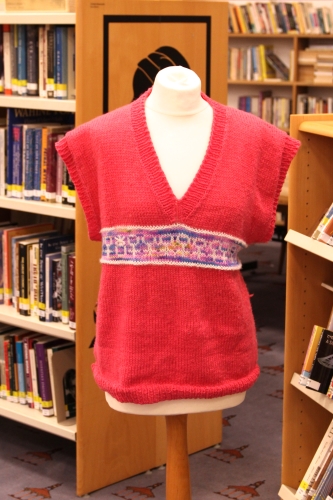
A lot has changed in the world of knitting over the last 40 years. It was just starting when the pattern was written, a shift away from a market dominated by yarn producers who made the knitter invisible, the designer anonymous and who gave you a pattern to be followed exactly as written and made with only their yarns. It didn’t leave knitters with much scope for self-expression or to alter a pattern to fit a body that wasn’t a commercial ideal. Even into the 90s and into the early 00s, it was still common for the patterns to be knitted as flat pieces of fabric and sewn together. This is because these yarn companies were using dressmaking techniques in their designs. Improving the skill of their customers and using the medium to its best advantage wasn’t a priority for them – they were interested in selling yarn and the end product, not in the process of knitting.1
The biggest change has been the internet. People whose knitting traditions contained different techniques could share them internationally with other knitters – suddenly we went from three cast-ons to a dozen, each suitable for different things. Knitters from a range of backgrounds began to experiment with and push the limits of the medium. The rise of big name designers would’ve been impossible in an industry that was still centred on the needs of the yarn manufacturers.
With the change in techniques, the market for materials changed. Double pointed needles were regularly used for gloves, hats and socks – so you could knit a single piece without seams by going in a continuous circle, rather than back and forth – but it’s not until the 1970s that circular needles really show-up in the UK. Even then, it needed a whole booklet of patterns in order for knitters to see their potential. This new connectivity, alongside international knitwear designers who think of the finished garment as a 3D object and know that the process is as important as the product, mean that most modern patterns are knitted without any seams.
The other shift in materials came from the movement for independent dyers (aka indie dyers). Dyeing has long been the poor cousin of the textile arts, oftentimes seen as a part of the process of another creation and lacking the romance of spinning or weaving, rather than recognised as a skill in its own right. With the Industrial Revolution and the move to synthetic dyes, women continued the traditions of small batch and natural dyes but it often got subsumed into other ‘domestic labour’, meaning their contributions and techniques have not been preserved in the same way.2 Other changes in knitting have been pretty extensively covered but dyeing has been neglected. It shows up as one of the crafts in the 1970s magazine Golden Hands but that’s mostly focused on tie-dye and batik cloth dyeing, not yarn.
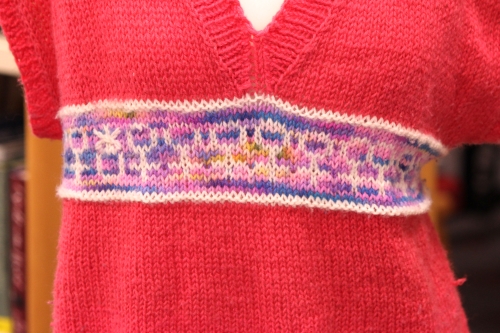
As I said, the early 2000s and the rise of the internet changed the cultural shape of knitting – and craft more broadly. Knitters sought “to reconcile and reconnect the aesthetic and political values of craft” which meant that not only what and how you made was changing but also what you knitted with.3 This isn’t the anti-capitalist, countercultural crafting of the 1970s that I touched on in Part 1. It is, however, a more intentional form of consumption that centres the small businesses of women – be it through designing patterns, dyeing yarn or running local yarn shops (LYSs). (There is a conversation to be had around class and which women have access to these types of craft spaces but that would be a whole essay in its own right.)
In the wake of the 2008 global financial recession, many people attempted to turn their hobby into a business, usually for supplementary income. Sites like Etsy became a key place to sell handmade products – including yarn – and the knitting social platform Ravelry has (as of February 2024) just shy of 1.3 million patterns in their database, many of which are available to purchase on the site.
Yarn, however, is a tactile object and two of the most important factors are its colour and feel.4 It’s normal in a LYS to be encouraged to ‘squish’ the yarn, to get a good feel of it. Colour on a screen isn’t reliable, you often need to see it in person to really know if it’s right for you. LYSs tend to stock smaller brands and indie dyers, who in turn benefit from their presence in LYSs. The internet has had a huge impact but it is in these offline spaces that women’s businesses interact and make space for each other.
All of which is a rather long winded way of saying that, in the 40 years since the Spare Rib jumper was published, knitters have reclaimed the methods of production, the materials of production and their economic power within knitting.
For me, the change in knitting methods is a godsend because (I’m going to let you in on a little secret) I am incredibly lazy. Which means I will do everything in my power to avoid seams. Even modifying a pattern so I don’t have to do any sewing at the end. That’s what I’m going to do to my version of the Woman’s Woolly: it will have no seams. And, because I’ve already decided to knit the “pullover”, I won’t be knitting any more sleeves either.
As I started writing about this, I realised explaining the difference between each technique was going to be incredibly boring for everyone involved. Experienced knitters will be familiar with some of them and don’t need me to explain all my idiosyncrasies to them. Not every change is worth going into in depth: my preference for one decrease over another really isn’t that interesting. And for non-knitters, having to explain the difference between them is going to be equally dull. So I made a handy little chart so knitters can see what I’ve changed and I can get on with talking about the process of making the jumper:
| Original Jumper | Intersectional Jumper |
|---|---|
| Knitted flat | Knitted in the round |
| Long tail cast on | German twisted cast on |
| K3tog every 8 rows | K2tog every 4 rows |
| Weave in ends | Russian join |
| Sl1 K1 psso | Ssk |
| P2tog tbl | Ssp |
| Cast off on rib | Jeny’s Surprisingly Stretchy Bind Off |
| Backstitch | Mattress stitch (but as little sewing as possible) |
| Press | Block |
| No armhole shaping | Some armhole shaping |
| Cast off shoulders | Kitchener stitch together |
Back to my old reliable cast-on for jumper bottoms, I cast on for both sides simultaneously. As the pattern repeat is a multiple of 6, I drop the seam stitch and cast on exactly 180. From there, it’s identical to the first jumper, only I’m going round and round rather than back and forth. I skip the pockets, not for any ideological reason, I just can’t be bothered with them. (Again, I’m a lazy knitter.)
Already by the time I start the band, I can feel the difference in the way the fabric drapes. It’s looser and more relaxed than the original. It’s entirely because of the mistake I detailed in Part 2 but I like it; it fits the aesthetic I’m aiming for better than something more densely knitted would. However, because the contrast between my two colours is less than the ones on the original jumper, the motif stands out less on the less dense fabric. If it were tighter, it would be more obvious (I know this because I knitted one in a tighter gauge for my teddybear) but I don’t hate it. Something about forcing people around me to double take and look closer at the jumper fits with my ideas of clothes as performance.
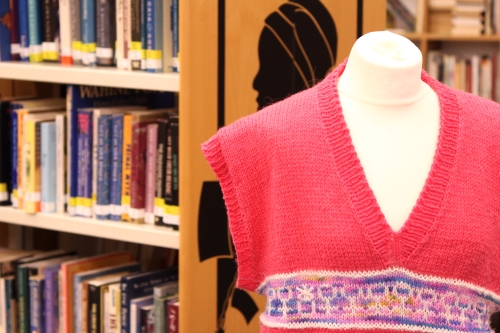
The biggest changes I make come as I separate for the shoulders – now, instead of going round and round, I’m going back and forth across half the stitches. What I realise is that, as I have quite a big bust but narrower shoulders, if I knit the jumper as written, I’m going to end up with a ‘sleeveless’ jumper that reaches my elbows. As I knit up the back, I decrease a few stitches at each end to narrow the shoulders. Not only have I now altered the jumper to fit my personality, I’ve altered it to fit my body as well.
Once I’ve done the front with the same alterations to the shoulders, it’s time for the finishing touches. Unlike with the original, I’m actually excited for this bit. I graft the shoulders together and then move on to the neck and armholes. If you’ve read Part 2, you know how much I detested this part on straight needles. But on my modern circulars, it’s a doddle; circular needles working on circular holes.
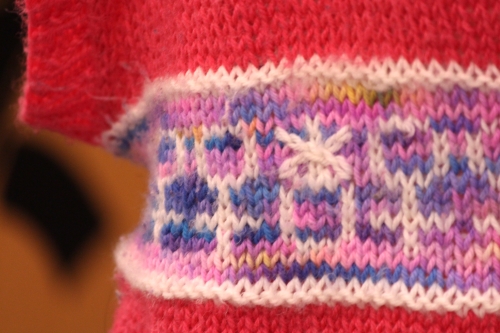
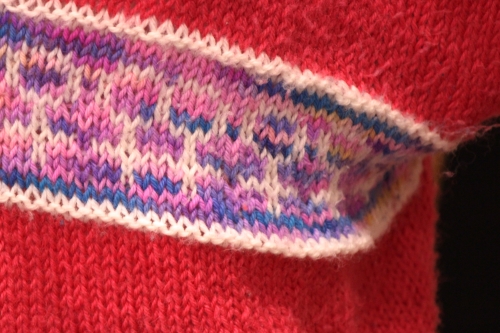
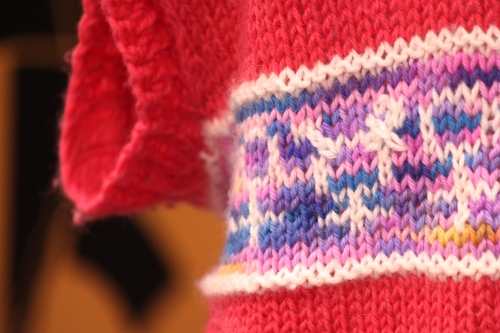
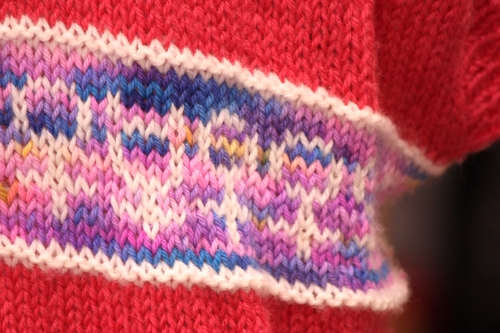
The last step, before sewing in the handful of ends, is to embroider on the final details to the trans and non-binary symbols. I use a little of the white yarn and a chain stitch to finish them off. Each stitch brings me closer to the end of this process and with it the end of this project.
I have two finished jumpers – one at GWL and one in my wardrobe – but what I also have is more than that. I’ve fallen down rabbit holes, spent hours and hours reading papers and finding books on many aspects of fashion and social history. It’s been everything I love about research: pleasure, frustration, obsession, inspiration. In these blog posts I’ve attempted to shape what I’ve learnt – supplemented with my own knowledge and experience – into something readable for knitters and non-knitters alike. Those moments when my brain fires with an insight and I have to catch it, mould it, give voice to it has been just as enjoyable to me as using my needles and fingers to shape yarn into jumpers. Both have been acts of creation built on the work and knowledge of other women.
So, yes, I’ve made two jumpers. But I’ve gotten so much more out of this project than just that. And I hope you have too.
- Marsh, M. Lilly. ‘Become the Boss of Your Knitting: Elizabeth Zimmerman and the Emergence of Critical Knitting’. Stitching the Self: Identity and the Needle Arts, edited by Johanna Amos and Lisa Binkley, Bloomsbury Visual Arts, 2021, pp. 49–65. ↩︎
- Casselman, Karen Diadick. ‘Women in Colour: Perceptions of Professionalism in Natural Dyeing during the Arts And Crafts Period’. Textile History, vol. 39, no. 1, May 2008, pp. 16–44. ↩︎
- Jakob, D. ‘Crafting Your Way out of the Recession? New Craft Entrepreneurs and the Global Economic Downturn’. Cambridge Journal of Regions, Economy and Society, vol. 6, no. 1, Mar. 2013, pp. 127–40. ↩︎
- Stannard, Casey R., and Kathy Mullet. ‘Consumption of Raw Materials by Crafters: Desired Characteristics of Yarn and Retailers’. Clothing and Textiles Research Journal, vol. 36, no. 1, Jan. 2018, pp. 17–32. ↩︎

Leave a Reply